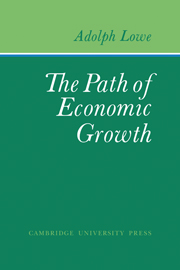Book contents
- Frontmatter
- Contents
- Preface
- Acknowledgments
- PART I The Basic Model
- PART II Changes in the Rate of Change
- PART III Changes in the Rate of Change
- PART IV Changes in the Rate of Change
- 21 The Scope of the Investigation
- 22 Dynamic Equilibrium Once More
- 23 Nonneutral Innovations: A General Survey
- 24 Pure Labor-Displacing Innovations
- 25 Pure Capital-Displacing Innovations
- 26 Some Comments on Combined Changes in the Input of Labor and Capital
- 27 Technical Progress and Diminishing Returns
- 28 Some Concluding Remarks
- Appendix: An Alternative Presentation of Lowe's Basic Model
- Glossary of Recurring Symbols
- Name Index
- Subject Index
21 - The Scope of the Investigation
Published online by Cambridge University Press: 07 October 2011
- Frontmatter
- Contents
- Preface
- Acknowledgments
- PART I The Basic Model
- PART II Changes in the Rate of Change
- PART III Changes in the Rate of Change
- PART IV Changes in the Rate of Change
- 21 The Scope of the Investigation
- 22 Dynamic Equilibrium Once More
- 23 Nonneutral Innovations: A General Survey
- 24 Pure Labor-Displacing Innovations
- 25 Pure Capital-Displacing Innovations
- 26 Some Comments on Combined Changes in the Input of Labor and Capital
- 27 Technical Progress and Diminishing Returns
- 28 Some Concluding Remarks
- Appendix: An Alternative Presentation of Lowe's Basic Model
- Glossary of Recurring Symbols
- Name Index
- Subject Index
Summary
Speaking in the broader terms of social welfare, technological change is the true stimulus of economic growth. Rising labor supply, considered in isolation, forces capital formation on the system if its members are “to stay where they are,” that is, if per capita output and consumption are to be maintained on the preexisting level. Only through the medium of technological progress in one of its many modalities can the members attain a rise in their material provision and can the notion of “growth” be extended beyond a mere aggregative concept.
In pointing to the many modalities under which technological change appears, I have mentioned a characteristic that will profoundly affect our treatment of the issue. There is, alas, no generally accepted classification for these modalities. Without offering an exhaustive listing, the following distinctions will help us in the selection of the problems with which we are going to deal.
There are, first of all, distinctions among invention, innovation, and technological change. Again we cannot fall back on a firm convention for the use of these terms. As far as the first two are concerned, we shall follow Schumpeter's suggestion that invention is concerned with the discovery of new technical knowledge, whereas innovation refers to the economic application of such new knowledge. The knowledge itself concerns either “novel ways of making old goods” or “old ways of making novelties.” Accordingly, we can distinguish in the realm of economic application between “process-innovation” and “product-innovation.” In what follows we shall identify process-innovation with technological change, which then becomes a subcategory of innovation generally.
- Type
- Chapter
- Information
- The Path of Economic Growth , pp. 235 - 239Publisher: Cambridge University PressPrint publication year: 1976



